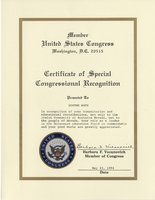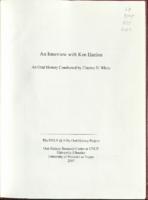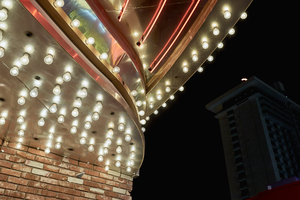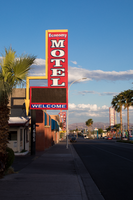Search the Special Collections and Archives Portal
Search Results
University of Nevada, Las Vegas. School of Nursing
In the 1950s and 1960s, Nevada experienced a nursing shortage, largely as a result of the lack of nursing schools in the state and rapid population growth. To address the problem, the Nevada Board of Regents approved the implementation of an associate degree program at the campus of Nevada Southern University (now known as the University of Nevada, Las Vegas) in 1965, and that fall the first students were admitted.
Corporate Body
Elsie and Richard Goldsworthy Collection of Las Vegas Ephemera
Identifier
Abstract
The Elsie and Richard Goldsworthy Collection on Las Vegas Ephemera (1960-1999) contains ephemera from hotels and casinos in Las Vegas, Nevada and includes programs, table tents, and postcards. There is additional material created by the Las Vegas Chamber of Commerce and invitations to special events hosted by various Las Vegas dignitaries. Additional materials includes programs and fliers from local theater companies in Las Vegas, Nevada.
Archival Collection
Terry Ritter Collection
Identifier
Abstract
The Terry Ritter Collection, dating from approximately 1995-2012, contains six color prints of Ritter's artwork depicting Las Vegas, Nevada showgirls. There is also one convention flier advertising her artwork.
Archival Collection
Renee Lee Papers
Identifier
Abstract
The Renee Lee Papers span from the 1950s to 2012 and document the life of singer and actress Renee Lee through photographs, her original music scores, newspaper clippings, and a mid-career resume. The collection also includes an alphabetized card catalog of the private performances Lee booked from 1998-2012.
Archival Collection
Lorraine Thomas-Perry Papers
Identifier
Abstract
The Lorraine Thomas-Perry Papers (1910-1936) contain the personal papers of Lorraine Thomas and her family, who were early residents of Beatty, Nevada. Collection materials include report cards, graduation certificates, correspondence, and short stories and poems written by family members. The majority of collection are photocopies. The collection also contains one original program for the opening banquet and ball for Hotel Fayle in Goodsprings, Nevada on May 13, 1916.
Archival Collection


Transcript of interview with Ken Hanlon by Claytee D. White, November 29, 2006
Date
Archival Collection
Description
Text

Chet Buchanan oral history interview: transcript
Date
Archival Collection
Description
Oral history interview with Chet Buchanan conducted by Barbara Tabach on November 28, 2017 for the Remembering 1 October Oral History Project. Chet Buchanan begins this interview with a discussion of his move to Las Vegas, Nevada in 1999 after he was offered a job as a radio show host for 98.5 KLUC. He talks about the specifics of his job, including his career background as well as the Chet Buchanan Toy Drive. For this interview, he specifically goes into detail on his coverage of the Las Vegas October 2017 mass shooting and discusses being in San Diego, California at the time, yet still striving to reach people through his broadcast with the help of CBS San Diego. Throughout the interview, Buchanan examines his desire to make a difference in the community with his show and his interactions with the public.
Text

Photographs of Las Vegas Club signs, Las Vegas (Nev.), June 24, 2016
Date
Archival Collection
Description
Site name: Las Vegas Club (Las Vegas, Nev.)
Site address: 18 Fremont St
Sign owner: Las Vegas Club
Sign details: The Las Vegas Club originally opened on the opposite side of Fremont than it is today in the 1930's. It held one of the first few Neon signs on Fremont which was installed around ca.1930. In 1949 the Las Vegas Club reopened in its new location on Main and Fremont Street, and once held a large Baseball Hall of Fame. It has closed down in 2015 and demolition of the building began in 2017.
Sign condition: 4- Signage was working well and still had bright paint before the building had undergone demolition
Sign form: Pylon and architectural
Sign-specific description: They convey sports themes throughout their signs. There was a bronze-type sculptural baseball player. Large Neon and incandescent sign that wrapped around the whole building. Though above each entrance there is a plain graphic lettering with neon surrounding the letters.
Sign - type of display: Neon and Incandescent
Sign - media: Steel and bronze-type material (baseball player)
Sign - non-neon treatments: Sculptural element and incandescent
Sign animation: Flasher for incandescent
Sign environment: This location is on the north corner of Main and Fremont St. It is just north of the Golden Gate and across the street from the Plaza. It also had the Golden Goose, Glitter Gulch and Mermaids to the East of it.
Sign manufacturer: YESCO
Sign designer: Brian "Buzz" Lemming
Sign - date of installation: Circa 1960's
Sign - thematic influences: They convey sports/baseball themes within their signage which showcases the theme of their Baseball Hall of Fame.
Survey - research locations: Neon Museum Tour Hand book, Vintage Vegas http://vintagelasvegas.com/search/Las+Vegas+Club Images, Charles Barnard The Magic Sign.
Survey - research notes: The original Las Vegas Club in the 1930's had the tallest tallest sign in downtown Las Vegas until it was superseded by the Lucky Casino sign about a decade later.
Surveyor: Wyatt Currie-Diamond
Survey - date completed: 2017-09-02
Sign keywords: Architectural; Steel; Sculptural; Incandescent; Flashing; Neon; Bullnose
Mixed Content

Photographs of Economy Motel sign, Las Vegas (Nev.), April 18, 2017
Date
Archival Collection
Description
Site address: 1605 Fremont St
Sign owner: Las Vegas Dragon Hotel LLC
Sign details: This building was constructed in 1953 for commercial living and motels and has been used for this since. This location was recently remodeled in 2016. The property previous to the Economy Motel was the Rangler Motel.
Sign condition: 5-looks newly restored
Sign form: Blade
Sign-specific description: The top of the sign is a red rectangular blade with the word "ECONOMY" in white skeletal neon tubes spelt out horizontally. Below the word Economy is the word "MOTEL" spelt out Vertically in channeled white letters with a blue border. Underneath this portion of the sign is a sign box where they have a plastic rectangular sign with their phone number on it. Under the sign box is "WELCOME" painted on the west side of the sign and "BIENVENDIO" on the east side. On the building side of the side box is a rectangular yellow arrow pointing down to the lobby of the motel.
Sign - type of display: Neon and plastic backlit sign
Sign - media: Steel and plastic
Sign - non-neon treatments: Plastic backlit sign
Sign environment: This location is on the East side of Fremont Street located close to many other motels some closed and some still open.
Sign - date of installation: Sign has been up but in a different form since at least 2007
Sign - date of redesign/move: Late 2016/ early 2017 repainted/ restored since it previously said Rangler Motel on the sign (had a plastic cover saying economy over that previous logo for a few years)
Sign - thematic influences: The arrow portion of this sign is a popular 1950's/60's motel sign theme.
Sign - artistic significance: It is a trend down on Fremont to take an old Motel sign and renovate it into the new motel's name and logo.
Survey - research locations: Owner's website http://www.1dragonhotel.com/about_us , assessor's map, Google map satellite view
Survey - research notes: The previous sign for the Rangler motel was repurposed for the Economy Motel, so the same MOTEL blade portion had the same font but channeled neon was added, as well as repainted.
Surveyor: Emily Fellmer
Survey - date completed: 2017-09-10
Sign keywords: Neon; Plastic; Steel; Pole sign; Electronic Message Center
Mixed Content
